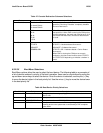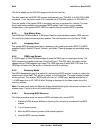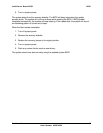
Intel® Server Board SDS2 BIOS
Revision 1.2
Order Number: A85874-002
65
Table 47. Console Redirection Submenu Selections
Feature Option Description
Serial Port Address Disabled
On-board COM A
On-board COM B
When enabled, Console Redirection uses the I/O port
specified. Choosing “Disabled” completely disables
Console Redirection.
Baud Rate 9600
19.2k
38.4k
57.6K
115.2k
When Console Redirection is enabled, use the baud
rate specified. When EMP is sharing the COM port as
console redirection, the baud rate must be set to 19.2
k to match EMP baud rate, unless auto-baud feature
is used.
Flow Control None
CTS/RTS
XON/XOFF
CTS/RTS + CD
None = No flow control.
CTS/RTS = Hardware based flow control.
XON/XOFF = Software flow control.
CTS/RTS +CD = Hardware based + Carrier Detect
flow control.
When EMP is sharing the COM port as console
redirection, the flow control must be set to CTS/RTS
or CTS/RTS+CD depending on whether a modem is
used.
6.3.2.3.5 Boot Menu Selections
Boot Menu options allow the user to select the boot device. The following table is an example of
a list of devices ordered in priority of the boot invocation. Items can be re-prioritized by using the
up and down arrow keys to select the device. Once the device is selected, use the plus (+) key
to move the device higher in the boot priority list. Use the minus (-) key to move the device lower
in the boot priority list.
Table 48. Boot Device Priority Selections
Boot Priority Device Description
1 Removable Devices Attempt to boot from a legacy floppy A: or removable media device
like LS-120.
2 Hard Drive Attempt to boot from a hard drive device.
3 ATAPI CD-ROM Drive Attempt to boot from an ATAPI CD-ROM drive.
4 PXE UNDI Attempt to boot from a network. This entry will appear if there is a
network device in the system that is controlled by a PXE compliant
option ROM.


















